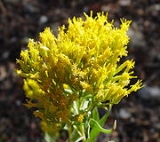
Chrysothamnus viscidiflorus
Encyclopedia
Chrysothamnus viscidiflorus is a species of shrub
in the daisy family
known by the common names yellow rabbitbrush and green rabbitbrush. It is native to western North America, from British Columbia
to California
to Nebraska
, where it grows in sagebrush
and woodland habitat. It grows easily in alkaline and saline soils, and thrives on soils that are rich in calcium
. It rapidly establishes in disturbed habitat, including burns, flooded washes, and rockslides, so it is a valuable shrub for revegetating damaged land such as overgrazed rangeland
and abandoned mining areas. This shrub grows up to about 1.5 meters in height with spreading brittle pale-colored stem branches. The leaves are up to a few centimeters long and may be thin and thready or up to a centimeter wide and oblong in shape. They are glandular, resinous, and sticky. The inflorescence
is a bushy cluster of flower heads
, each head one half to one centimeter long. The flower head is lined with sticky yellow-green phyllaries
and contains several yellowish protruding flowers. The fruit is a hairy achene
a few millimeters long with a wispy pappus
at the tip.
Shrub
A shrub or bush is distinguished from a tree by its multiple stems and shorter height, usually under 5–6 m tall. A large number of plants may become either shrubs or trees, depending on the growing conditions they experience...
in the daisy family
Asteraceae
The Asteraceae or Compositae , is an exceedingly large and widespread family of vascular plants. The group has more than 22,750 currently accepted species, spread across 1620 genera and 12 subfamilies...
known by the common names yellow rabbitbrush and green rabbitbrush. It is native to western North America, from British Columbia
British Columbia
British Columbia is the westernmost of Canada's provinces and is known for its natural beauty, as reflected in its Latin motto, Splendor sine occasu . Its name was chosen by Queen Victoria in 1858...
to California
California
California is a state located on the West Coast of the United States. It is by far the most populous U.S. state, and the third-largest by land area...
to Nebraska
Nebraska
Nebraska is a state on the Great Plains of the Midwestern United States. The state's capital is Lincoln and its largest city is Omaha, on the Missouri River....
, where it grows in sagebrush
Sagebrush
Sagebrush is a common name of a number of shrubby plant species in the genus Artemisia native to western North America;Or, the sagebrush steppe ecoregion, having one or more kinds of sagebrush, bunchgrasses and others;...
and woodland habitat. It grows easily in alkaline and saline soils, and thrives on soils that are rich in calcium
Calcium
Calcium is the chemical element with the symbol Ca and atomic number 20. It has an atomic mass of 40.078 amu. Calcium is a soft gray alkaline earth metal, and is the fifth-most-abundant element by mass in the Earth's crust...
. It rapidly establishes in disturbed habitat, including burns, flooded washes, and rockslides, so it is a valuable shrub for revegetating damaged land such as overgrazed rangeland
Rangeland
Rangelands are vast natural landscapes in the form of grasslands, shrublands, woodlands, wetlands, and deserts. Types of rangelands include tallgrass and shortgrass prairies, desert grasslands and shrublands, woodlands, savannas, chaparrals, steppes, and tundras...
and abandoned mining areas. This shrub grows up to about 1.5 meters in height with spreading brittle pale-colored stem branches. The leaves are up to a few centimeters long and may be thin and thready or up to a centimeter wide and oblong in shape. They are glandular, resinous, and sticky. The inflorescence
Inflorescence
An inflorescence is a group or cluster of flowers arranged on a stem that is composed of a main branch or a complicated arrangement of branches. Strictly, it is the part of the shoot of seed plants where flowers are formed and which is accordingly modified...
is a bushy cluster of flower heads
Head (botany)
The capitulum is considered the most derived form of inflorescence. Flower heads found outside Asteraceae show lesser degrees of specialization....
, each head one half to one centimeter long. The flower head is lined with sticky yellow-green phyllaries
Bract
In botany, a bract is a modified or specialized leaf, especially one associated with a reproductive structure such as a flower, inflorescence axis, or cone scale. Bracts are often different from foliage leaves. They may be smaller, larger, or of a different color, shape, or texture...
and contains several yellowish protruding flowers. The fruit is a hairy achene
Achene
An achene is a type of simple dry fruit produced by many species of flowering plants. Achenes are monocarpellate and indehiscent...
a few millimeters long with a wispy pappus
Pappus (flower structure)
The pappus is the modified calyx, the part of an individual disk, ray or ligule floret surrounding the base of the corolla, in flower heads of the plant family Asteraceae. The pappus may be composed of bristles , awns, scales, or may be absent. In some species, the pappus is too small to see...
at the tip.

